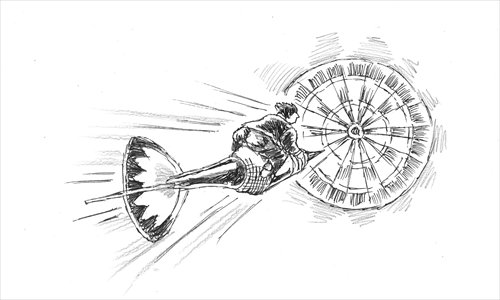HOME >> BUSINESS
Maintaining growth not an impossible task for China
By Liu Zhiqin Source:Global Times Published: 2016-3-4 0:33:01

Illustration: Peter C. Espina/GT
As China's top political advisory body convened its annual meeting Thursday and with the country's top legislature set to begin Saturday, public attention seems to be focused on how local governments are setting their GDP targets for 2016.
Certain local governments are becoming rather conservative about setting a high GDP target, and avoid talking about high-speed economic development. We should raise awareness of the low-key way local governments have behaved, because it's unsure whether such an attitude represents the reality of local economic development, or speaks for the public opinion.
Statistics have shown that about half of China's provincial governments lowered their GDP targets for 2016, which will influence the country's GDP growth target this year. Beyond these targets, there should be more focus on the provincial economic realities and problems.
First, in provinces and cities that relied on coal and cement production, there is huge pressure for productivity restructuring and the search for alternative growth engines. In these areas, challenges in dealing with overcapacity, destocking, and finding new growth momentum and opportunities persist.
Second, different parts of China have different attitudes toward growth. While provinces in northern China are sparing no efforts to maintain GDP growth, provinces in southern China have been more conservative with their 2016 GDP targets.
When analyzing economic indicators for the Yangtze River Delta, the local governments have been rather conservative about their 2016 economic plans, and they seem to share concerns over future economic development.
Meanwhile, the economic circumstances in Northeast China play a crucial role in the country's economic landscape. The economic performance of Heilongjiang, Jilin and Liaoning provinces was less than satisfactory last year, but people still hope they can prop up China's economic growth as they used to. Even though Northeast China is under tremendous pressure, with proper incentives for industrial transforming and upgrading from the central government, a much brighter future lies ahead.
Third, there might be certain misunderstandings about GDP. Some tend to believe that promoting GDP growth cannot progress hand in hand with environmental protection. In this regard, many local governments have emphasized the importance of a green economy in their annual government work reports, which serves as a reason to lower local growth targets. But this lacks a scientific basis. There should be a friendly combination of these two, offering both growth and environmental protection.
Also the notion that rapid economic growth cannot coexist with quality of growth is not absolute, as it depends on how relevant policies are made and implemented. It is true that previous fast development has to some degree neglected economic quality, and a huge amount of resources have been wasted. But lessons have been learned and the country has gained better experience in scientifically managing the relationship of growth speed and quality.
Last, as the central government has emphasized the "new normal" of economic growth within a mid-to-high range, certain local governments are likely to have the tendency to set even lower growth targets. Admittedly, by doing this certain risks might be avoided, but it could dampen economic performance, making the market less active.
As China is undergoing a phase of structural adjustment, big fluctuations could cause a negative effect on the overall economy. The steel, cement, and aluminum industries are burdened with overcapacity, and it takes a long time to resolve such problems. Other industries such as clothing and textiles are also struggling to avoid this situation. So when it comes to the making of government work reports, local governments must provide opportunities for industries to fulfill their structural upgrading process.
When talking about a country's economic situation, almost every nation would refer to the same phrase - external influences. European countries and the US always claim to be affected by poor performance in external markets when they have difficulty maintaining economic growth. Similarly, when China faces an economic downturn, China also points to external markets, saying the slowdown is partly a result of decreasing demand from Western countries. But even though the economic correlation between China's domestic market and external markets is very high, it's no longer persuasive enough to blame the other side for GDP cuts.
The pressing matter right now is to solve internal issues. We should take the initiative to improve the supply side while also booting demand. Three pairs of issues should reach a proper balance: economic development and environmental protection; speed and quality of growth; and external and internal forces. According to media reports, 10 of China's provincial-level regions entered the club of having per-capita GDP of above $10,000 in 2015. And GDP in Guangdong, Jiangsu and Shandong provinces in 2015 exceeded 6 trillion yuan ($917 billion). This demonstrates that despite the economic slowdown, China's fundamentals are still solid, and a mid-to-high growth rate can be achieved.
According to data from research firm Nielsen Co, China's consumers' willingness to spend increased by 2 percentage points year-on-year to 48 percent in 2015, the highest level in the past four years. This suggests the Chinese people are quite positive about the country's future economic prospects.
The author is a senior fellow at the Chongyang Institute for Financial Studies at Renmin University of China. bizopinion@globaltimes.com.cn
Posted in: Expert assessment